A Whole Grain Primer
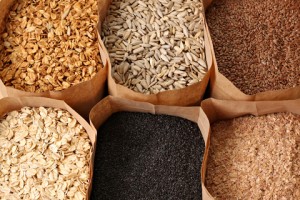
You’ve heard that you’re supposed to eat more of them, but what the heck are whole grains, exactly?
Whole grains are grains that haven’t had their bran and germ removed by milling. They’re considered a better source of fiber, nutrients and antioxidants than their refined cousins. Whole grains can decrease cholesterol levels, blood pressure and risk of heart disease, and some studies have found that whole grains help reduce the risks of certain types of cancer.
The whole grain family includes brown rice, buckwheat, farro, millet, oatmeal, whole-wheat flour and whole cornmeal, among others. The FDA recommends eating at least three one-ounce equivalents of whole grains per day. Want to see if your packaged food product contains whole grain? It’s easy. Just look for the word “whole” in the ingredient list.
If you’re a refined-grain guru, incorporating whole grains into the diet might seem like a pain, but trust me, it’s pretty painless if you start small. For instance, substitute whole-wheat pasta or go for whole-grain bread products (think bagels, English muffins, tortillas, etc.) for white-flour options. Or if you’re baking, try using half whole-wheat pastry flour in cookie, cake or pie recipes. I’ve had particular luck with this in bar-cookie recipes, like these pumpkin chocolate chip squares (it’s also been virtually undetectable in 7-layer bars and other bar cookies). Whole wheat pastry flour is a much finer grind than regular whole-wheat flour, and while yes, the texture is a little teeny bit different, it’s not off-putting. In fact, once you get used to it, you might actually prefer the slightly nutty taste of the whole wheat pastry flour.
A dinner-time suggestion: Try brown rice instead of white. Use vegetable or chicken broth rather than water (same ratio as white rice – two cups broth to one cup of rice, and try adding a teaspoon of olive oil and a pinch of salt to boost the flavor). Or switch out rice altogether and give quinoa a whirl. If you’ve read this blog for a while, you know that I’m a huge fan of this high-protein seed. It acts like a grain, cooks quickly and has a light, nutty flavor. [Read more →]
January 27, 2010 1 Comment
Guest Post: Play More, Eat Less

In today’s guest post, Daniel Max reminds us that we can take the emphasis off food by finding something that really engages us . . . .
***************************************************************
Do you remember being a child and getting so wrapped up in creative play that you didn’t want to stop when it was time to eat or left your meal half-finished to get back to your game? Children innately understand that food is secondary to what is most nutritious and primary in life: fun and play.
As adults we seem to have lost our instinct to prioritize play. In our busy world, with its emphasis on work and responsibility, in order to be healthy and balanced we must work on more than just our bodies; we must feed our hearts, minds and spirits.
When our body, mind and spirit are engaged in a creative project or happy relationships, our reliance on food may appear to decrease. Likewise, when unsatisfied with relationships, job or other areas of our life, we often depend on food to cheer, soothe or numb us. When our life is out of balance, no amount of food can feed us where we truly need nourishment. The food that we eat is very important for health and balance, but what really feeds us-a full and fulfilling life-doesn’t come on a plate.
Putting things that excite us on hold for the sake of responsibilities may at times be good logic yet we often make these decisions from a place of fear rather than good sense. “If I’ll lose weight, then I’ll start swimming/ buy new clothes/ start yoga….” Let’s do the things we want to do NOW. Any statement containing “if I achieve__then I’d be happy” never holds truth and brings nothing but dissatisfaction. While our future goals are a motivation to better ourselves, they do not hold back our happiness. Finding a peaceful pleasure in our current state of being will motivate us to progress from a sense of ease. We stop working away from what we don’t want and work towards moving towards what we do want.
Create a positive attitude and wonderful environment around you and enjoy the process of becoming healthier and happier every step of the way!
Have fun. If going to the gym is a “chore” then try a yoga or dance class instead. Find a way to play while moving your body. If by deciding to eat healthy you are mostly focused on what to restrict, shift your focus to all the new foods and flavors you get to incorporate and explore.
What is fun for you? What makes you light up and excites you? Make time for it this week. Even if you don’t have much time for fun, try approaching a “serious” activity with an attitude of play. This can greatly reduce stress and anxiety and bring more pleasure to your day. Take your focus off food, try adding more fun into your life and watch the magic unfold.
 Daniel Max is a Nutrition and Health Counselor, Life & Wellness Coach, Massage Therapist specializing in Shiatsu, and a Yoga Instructor. Providing an integrative approach to naturally reclaim control of your health, Daniel offers an initial hour-long consultation. Gaining a greater perspective on your health, this session includes a full discussion of your health history and health goals, a chance to get your questions answered and establish your first steps in creating a personalized health program, completely catered toward your lifestyle and needs. Consultations are available either by phone or in person. To Learn more about Daniel and his services, visit www.MaxSenseOfSelf.com.
Daniel Max is a Nutrition and Health Counselor, Life & Wellness Coach, Massage Therapist specializing in Shiatsu, and a Yoga Instructor. Providing an integrative approach to naturally reclaim control of your health, Daniel offers an initial hour-long consultation. Gaining a greater perspective on your health, this session includes a full discussion of your health history and health goals, a chance to get your questions answered and establish your first steps in creating a personalized health program, completely catered toward your lifestyle and needs. Consultations are available either by phone or in person. To Learn more about Daniel and his services, visit www.MaxSenseOfSelf.com.
January 26, 2010 No Comments
10 for ’10

January’s not over yet, how are your goals and resolutions coming along? Are you making progress? As my trainer likes to say “progress, not perfection!” She’s on to something . . . if we strive for perfection, we set ourselves up for disappointment. If we seek to progress, then we allow ourselves to celebrate each small step on the way to our ultimate goal.
On this theme, here’s a list of 10 ways you can healthy-up your life in 2010 - some small changes to set you on a path to better living in the new year.
1. Ease up on animal fats. Animal products can contain synthetic hormones, antibiotics and chemicals such as dioxin, DDT and other pesticides, which concentrate in animal fat. The chemicals that accumulate in animal fats are transferred to our bodies when we eat them. When buying meat, poultry or dairy, look for low fat options. You can also do your body a favor by reducing how much meat you eat. Making even one vegetarian meal a week can make a big difference.
2. Go organic where you can. According to the Environmental Working Group, you can lower your pesticide exposure by 90% by avoiding the most contaminated conventionally grown produce: peaches, apples, sweet bell peppers, celery, nectarines, strawberries, cherries, lettuce, imported grapes, carrots, and pears. You can download the EWG pocket guide to fruits and veggies here.
3. Ban the can. Canned foods and beverages are lined with a resin that contains bisphenol-A (BPA), a hormone-disrupting chemical that’s building up in our environment and our bodies. The FDA is investigating as we speak, and most manufacturers are beginning to explore safer alternatives, but in the meantime you should choose foods that are fresh, dried, frozen or packaged in glass jars or tetra packs.
4. Read food labels – for real. Ever stop to read the ingredients label on packaged, processed foods? Learn which food additives are safer by visiting The Center for Science in the Public Interest’s food safety guide. Remember this: The shorter the list of ingredients, the less processed the food, and the less processed the food, the better it is for your body.
5. Wet your whistle with water. Americans drink an overwhelming amount of soda, sports drinks, energy boosters, juices and other bottled beverages. Many of these drinks are loaded with sweeteners and artificial flavors and colors. They’re also often bottled in plastic, which can leach additional chemicals into your drink. Make an investment in a reusable stainless steel bottle, and get in the habit of filling it with water before you leave the house.
6. Eat-in more often. When you eat at a restaurant or stop for take-out, you have very little control over what you’re eating. Save money, protect your health, and trim your waistline by cooking at home. Look for inspiration here at Semi-Sweet, and also check out my links for fast and flavorful recipes that’ll ease your dependence on take-out and increase your intake of whole foods, fruits and veggies.
7. Use fewer personal care products and use them less often. Our government doesn’t currently require health studies or pre-market testing for personal-care products before they’re sold. Nearly 90% of ingredients used in personal care products haven’t been evaluated for safety by any publicly accountable institution. Nearly all these chemicals can penetrate the skin, and some we ingest directly from our lips or hands. Visit the Campaign For Safe Cosmetics to learn more and to see what’s really in those products you use every day.
8. Kick the non-stick. Non-stick pans are coated with synthetic chemicals, and when the cook-surface gets scratched, tiny, yet toxic bits of inert plastic and leached aluminum cling to your food. What’s more, these pans emit toxic fumes when overheated. The safest alternatives are cast iron, stainless steel and oven-safe glass. If you have unscratched non-stick cookware and can’t afford to replace it right now, you can reduce the possibility of toxic fumes by cooking smart: never preheat nonstick cookware at high heat, don’t put it in an oven hotter than 500 degrees and use an exhaust fan over the stove.
9. Store & reheat leftovers safely. Avoid plastic when storing and re-heating leftovers. We know that chemicals routinely migrate into food and liquid placed in plastic containers and that heat accelerates the process. Use a paper towel instead of plastic wrap to cover food in the microwave, and use glass or ceramic food storage containers.
10. Clean greener. Our homes aren’t safe and clean if the air inside is polluted with chemicals from household cleaners. It’s pretty easy: Try natural alternatives (vinegar, baking soda and water); avoid anti-bacterials; and avoid the biggest hazards (acidic toilet bowl cleaners, air fresheners, oven cleaners, and corrosive drain openers).
January 25, 2010 4 Comments
Thursday Night Recap
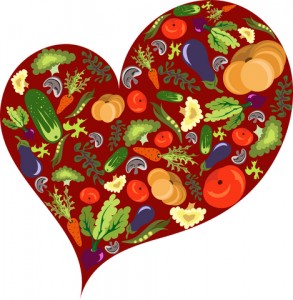
Happy Friday morning, all! We had a great time at Healthy Habits Kitchen last night – thanks to Sue for hosting us (and for providing tasty treats!) and to Liz Ward for giving us all great advice on how to make nutrition a family affair. I think we all came away with some great ideas for how to feed our families (and ourselves) a little bit better.
Liz’s advice was balanced and practical – and comes from a place of inclusion rather than exclusion of specific foods. This anti-deprivation message works well for us and for our kids: Instead of thinking of all the foods you “can’t” have (i.e., chips, cookies, Goldfish, Cheetos, etc.), think of all the nutrient rich-foods you can have (whole fruits, vegetables, whole-grain breads, low-fat milk, lean sources of beef, fish, chicken, nuts, etc. etc.). These whole foods add value to your diet. At our house, we call them “grow foods,” as distinguished from “treats,” which taste great and are fun to eat, but which we eat occasionally, not regularly. We let L. pick, choose, and eat as many “grow foods” as she likes, while we seek to limit (and have her self-limit) her intake of treats.
My #1 revelatory idea from the night was that it’s not a great idea to try to introduce new foods to your child when s/he is tired, overstimulated, etc. This was a lightbulb moment for me because I realized that we most often try to get L. to try new things at dinnertime – a time of, well, bonkers behavior most nights. So I’m going to try more during a weekend lunch, the afternoons or mornings on weekends, etc.
Another important take-away for parents is to try to manage your own anxiety about your child’s eating habits . . . let your desire for them to eat a balanced diet come from a place of love and interest, rather than a place of fear . . . because as Liz said, when fear takes over, all you-know-what can break loose. Or, as I say, kids can smell fear – and boy, do they capitalize on it!
I hope you all have a great, healthy weekend, and I’ll see you back here on Monday!
January 22, 2010 2 Comments
Jazzy Veggies
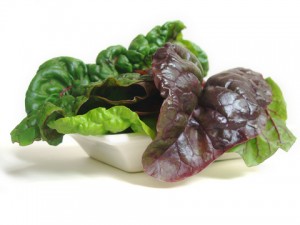
So right. You’re trying to eat more vegetables in 2010? You’re trying also to eat them un-creamed, without oozing cheese, etc. because maybe you’re also trying to be healthier and/or lose a few lbs.? But aren’t those steamed veggies a little boring??? I think so. Don’t get me wrong. Sometimes you need to go hard-core and slam down some plain steamed broccoli with lemon juice, but most of the time, no. If you’re counting calories or points, you can budget in a little sauce here and there, and let me tell you, it actually makes eating scads of greens . . . dare I say . . . enjoyable? Here’re some ideas for pepping up your produce.
To Lightly Steamed Broccoli, Add
Dijon Vinaigrette: extra-virgin olive oil, sherry vinegar, Dijon mustard, Kosher salt and freshly ground black pepper to taste.
Sesame Vinaigrette: dark sesame oil, rice wine vinegar, soy sauce and optional chili oil for heat.
Curried Mango Mayo: mayonnaise, Major Grey’s chutney, curry powder.
Italian-Style: Add extra-virgin olive oil to a large skillet and saute the broccoli ’til crisp-tender. Sprinkle with finely grated Parmesan cheese and hot pepper flakes. Optional – add a thinly sliced garlic clove to your oil and saute for 30 seconds before adding your broccoli.
To Lightly Steamed Green Beans, Add:
Yogurt & Tahini Sauce: Greek yogurt, tahini, Kosher salt and freshly ground black pepper to taste and a drizzle of lemon juice to finish.
Olive Tapenade:Add a bit of pre-made tapenade to your beans. Make it a meal by adding fresh mozzarella, hard cooked eggs, roasted peppers, etc.
Herb Butter: Mix unsalted butter with chopped fresh herbs such as thyme, marjoram, etc. and some Kosher salt and freshly ground black pepper to taste.
To Cooked Carrots, Add:
Chili Butter: Butter, chili powder, Kosher salt and freshly ground black pepper to taste.
Honey Mustard: Butter, honey, Dijon mustard, Kosher salt and freshly ground black pepper to taste.
To Winter Squash, Add:
Sage Butter: Butter, chopped fresh sage, Kosher salt and freshly ground black pepper to taste.
Harissa: Remember this stuff? Add a little extra-virgin olive oil and Kosher salt and freshly ground black pepper.
Moroccan Spices: Sweet paprika, cumin, cayenne, olive oil and Kosher salt and freshly ground black pepper. If you have them on hand, chip up a bit of fresh cilantro and/or parsley to sprinkle over the top.
Sweet Fix: Maple syrup or agave nectar, pumpkin pie spice, and if you want extra richness, add some butter.
January 21, 2010 5 Comments
Quick Chorizo & Chickpea Soup With Spinach
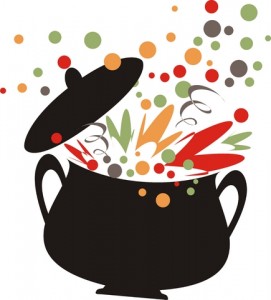
It’s official, folks, I’m on a soup bender. More gross weather on Tuesday in Boston . . . cold, snowy, gray . . . what better soup weather? Plus, I didn’t know if D. was going to make it home in time for dinner, so I wanted something that would hold ’til he got home to eat. I got inspired by a post on the Epicurious blog and 30 minutes later, I was sipping a bowl of hot, spicy goodness. After he got home and ate, D. said that “this one is even better than the bean and barley one the other night . . . .” This one is a helluva lot faster, for sure. Enjoy!
Chorizo & Chickpea Soup With Spinach
2 T. extra virgin olive oil 1 onion, diced 4 cloves of garlic, minced 12 oz. pre-cooked chorizo sausage (such as Welshire Farms or Niman Ranch), halved lengthwise and cut into 1/2-inch slices 1 can chickpeas with their liquid (remember, Eden Organics has no BPA) 3 c. diced tomatoes (Pomi in the tetra pak has no BPA) 1.5 c. strained tomatoes 6 c. low sodium chicken stock 1 t. cumin 1 t. oregano 1 T. red wine vinegar Several (5 or 6 or to taste) large handfuls of baby spinach Kosher salt and freshly ground black pepper to taste Freshly grated sharp cheddar cheese for serving
Heat the olive oil in a stockpot or large Dutch oven over medium heat. Add the onions and saute until they’re translucent. Add the garlic and saute just until fragrant, about 2 minutes. Add the chorizo and stir. Add the chickpeas, diced and strained tomatoes, chicken stock, cumin and oregano, stirring to combine. Bring to a boil, then reduce heat to low and simmer for 10 minutes. Remove lid, add vinegar and salt and pepper to taste. Add spinach, stirring to wilt. Serve with grated cheddar on top. Great with a crusty loaf of bread to help sop up the spicy broth.
Serves 4.
January 20, 2010 1 Comment
Quickie Quinoa Pilaf

Parents, you know those days when you swear the clock is broken? Or that maybe it’s . . . moving backwards? That was our Monday holiday. Cruddy weather, plans for a trek to the South Shore to redeem gift certificates and visit Daddy and Grampy thwarted. Blah. Luckily our good buddies down the road were in the same position, so we rounded up the kiddos for a snowy park playdate. But as I trundled L. home at 5, I thought “and now I have to COOK DINNER?” Not in the mood. I whipped up this easy pilaf in about 10 minutes, slapped some Stonewall Kitchen Vidalia Onion and Fig Sauce on a chicken breast and steamed some broccoli. 30 minutes to a complete meal, with a fruity, nutty pilaf on the side. It was the best part of the day.
Quinoa Pilaf With Fruit And Nuts
1 T. extra virgin olive oil1 onion, chopped
1 c. uncooked quinoa, rinsed and drained
2 c. low-sodium chicken broth
1/2 t. Kosher salt
2/3 c. dried cranberries
2/3 c. sliced almonds, toasted
Heat oil in a medium saucepan over medium heat. Add the onion and cook, stirring often, until the onion is translucent. Add the quinoa and toast, stirring constantly, for 1 minute. Stir in the broth, salt and cranberries and bring to a boil; reduce heat to medium low, cover and simmer until liquid is completely absorbed and quinoa is tender, 15-20 minutes. Toss with almonds and serve.
Serves 6. Make it vegan by subbing vegetable broth for the chicken broth.
January 19, 2010 No Comments
Fava Bean & Barley Soup
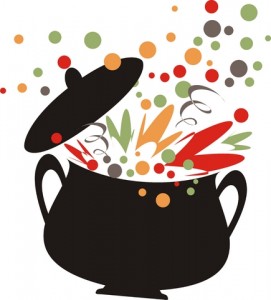
This rich, thick and hearty soup came about thanks to two fellow Boston bloggers, Kelly and Sues. After reading my tortelloni soup post, they both encouraged me to check out the New England Soup Factory Cookbook, so, I immediately ordered it up via the Minuteman Library Network. This is my usual M.O. when I’m curious about a cookbook – I vet it via the library and decide if I want to add it to “The Collection” or not. “The Collection” is getting so large that it’s going to have to move outside the kitchen very soon . . . so there’s no room for stragglers.
This, is a GREAT cookbook – thanks Kelly & Sues! There are so many good-looking recipes here – seasonal soups (think cool, light soups for summer, root veggie soups for winter), simple childhood favorites like Alphabet soup, creamy chowders, tomato-based soups, and sandwiches and salads to go alongside. On the first pass-through, I flagged 7 soups that particularly stood out for me, and this one was one of them. I wasn’t disappointed!
As is my way, I tweaked and doctored. This recipe turns out a vat of inexpensive, hearty, savory soup that’ll stick to your ribs. D., at first skeptical, pronounced it “delicious,” which is good, ’cause unless I freeze this, we’ll be eating it all week . . . .
Fava Bean & Barley Soup
1 lb. dried peeled and split fava beans (a.k.a. butter beans or broad beans) 3 T. extra virgin olive oil 2 yellow onions, peeled and diced 4 cloves garlic, minced 4 carrots, peeled and sliced into 1/2-inch rounds 4 ribs celery, diced 1/2 lb. pearl barley 12 c. low-sodium chicken broth, plus more as needed 2 bay leaves 1/2 c. fresh parsley, chopped 6 dashes Worcestershire sauce, plus more to taste 1 T. balsamic vinegar Kosher salt and freshly ground black pepper, to taste
To prepare the fava beans: rinse and pick over the beans and discard any discolored beans or pebbles. Put the beans in a bowl and cover with water. Let stand overnight, then drain and rinse. Alternatively, in a large saucepan, combine the beans with enough water to cover. Cover the pan, and bring to a boil. Turn off the heat and let the beans sit for two hours. Drain them before adding to the soup.
Heat the oil in a stockpot or large Dutch oven (this just fit in my 7 1/4-quart Dutch oven) over medium high heat. Add the onion, garlic, carrots and celery. Saute until the onion is translucent and the celery is softened, about 10 minutes. Add the beans and the barley and saute for another 2 minutes. Add the stock and the bay leaves. Bring to a boil; reduce the heat and simmer for 1 1/2-2 hours or until the favas are thoroughly cooked, adding more stock if the soup is too thick (I probably added another 2 c. part-way through the cooking time). Add the parsley, Worcestershire sauce, vinegar, salt and pepper. Remove the bay leaves before serving.
Serves 12. Note – if you’re tasting the soup prior to adding the Worcestershire, etc., it’ll be quite bland . . . those last few ingredients make it all come together in a delicious flash of light, so don’t be discouraged!
What the heck are fava beans? I love ‘em, and have eaten them for years – again probably because of my Mid-East roots. If they’re new to you, here are some facts: Fava beans were enjoyed by the ancient Egyptians and continue to be a prime source of protein in Middle Eastern cuisine. Favas are considered by many to be one of the tastiest beans – they have a firm texture and creamy, meaty taste that holds up well to strong flavors. Fava beans hold their shape well, so they’re great in soups. They do have a very tough, inedible skin, so it’s important to get dried favas with the skins already removed.
January 18, 2010 3 Comments










